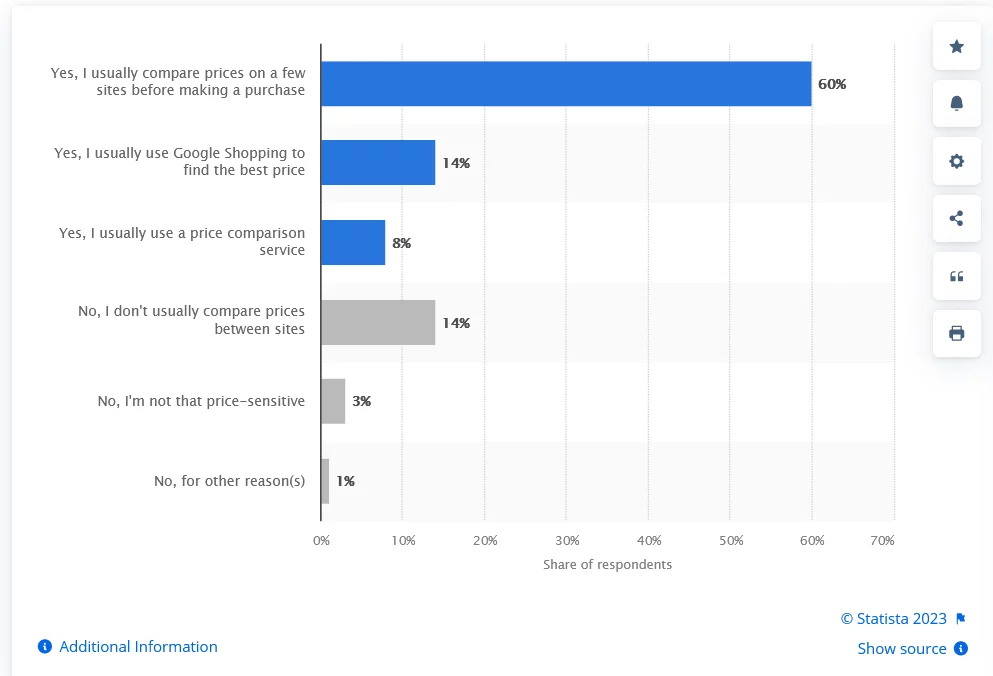Price comparison websites have revolutionized the way consumers shop online, offering a comprehensive platform to compare products, prices, and deals across various retailers. The impact of these platforms is substantial, shaping consumer behavior and influencing purchasing decisions. Consider these statistics that highlight the significance of price comparison websites:

Source: Share of shoppers who usually compare prices before buying online in the United States as of August 2022
- Consumer Preference:
- Over 80% of shoppers use price comparison websites to research products before making a purchase.
- About 60% of consumers worldwide visit comparison sites at least once a week.
- Sales Impact:
- Products listed on price comparison sites experience a 30% increase in sales on average.
- Retailers leveraging these platforms witness a notable uptick of up to 25% in conversion rates.
- Market Reach:
- Price comparison websites attract millions of visitors monthly, with some platforms boasting over 30 million monthly users.
- These sites cater to diverse markets, with regional variations in usage; for instance, in the US, over 40% of shoppers use price comparison sites regularly.
- E-commerce Influence:
- The growing e-commerce industry is significantly impacted by these platforms, contributing to a significant portion of online sales.
- Approximately 70% of online shoppers believe comparison sites help them find the best deals and prices available.
- Mobile Accessibility:
- Over 60% of visits to price comparison websites are from mobile devices, highlighting the importance of mobile-friendly interfaces.
- Conversion Boost:
- Products listed on multiple comparison sites witness a conversion rate increase of around 20% compared to those listed on only one platform.
Benefits of Price Comparison Websites for Sellers:

1. Expanded Reach and Visibility:
- Broader Audience: Listing products on comparison sites exposes them to a wider audience beyond your website, tapping into users specifically searching for deals and comparisons.
- Increased Exposure: Enhances brand visibility as your products are showcased alongside competitors, potentially attracting more customers.
2. Enhanced Customer Acquisition:
- Qualified Traffic: Attracts highly targeted and pre-qualified traffic—users visiting comparison sites are often in the purchasing phase, actively comparing prices.
- New Customer Acquisition: Provides an opportunity to acquire new customers who might not have discovered your brand otherwise.
3. Competitive Advantage:
- Comparison Shopping: Allows customers to compare prices, features, and reviews of your products against competitors, potentially positioning your offerings favorably.
- Dynamic Pricing: Enables you to adjust prices dynamically to stay competitive and attract more customers.
4. Improved Conversion Rates:
- Informed Purchase Decisions: Helps customers make informed decisions by providing comprehensive information and comparisons, potentially leading to higher conversion rates.
- Trust and Credibility: Positive reviews and ratings on these platforms can enhance credibility, encouraging trust among potential customers.
5. Data-Driven Insights:
- Performance Metrics: Access to analytics and performance metrics on these platforms helps track sales, clicks, and customer behavior, providing insights for better decision-making.
- Competitive Insights: Gain valuable insights into competitors’ pricing strategies and product performance.
6. Cost-Effective Marketing:
- Performance-Based Payment: Often operates on a pay-per-click or commission-based model, allowing you to pay for actual results rather than upfront advertising costs.
- Efficient Budget Allocation: Enables efficient allocation of marketing budgets, directing resources to platforms that yield better returns.
7. Adaptation and Optimization:
- Adaptation to Trends: Allows adaptation to changing market trends and customer preferences by adjusting product listings, pricing, and marketing strategies accordingly.
- Optimization Opportunities: Provides opportunities to optimize product listings, descriptions, and pricing strategies based on real-time data and customer feedback.
Benefits of Price Comparison Websites for Customers:

1. Convenient Shopping Experience:
- Centralized Platform: Provides a single platform to compare prices, features, and reviews of various products across multiple retailers, saving time and effort.
- Ease of Access: Allows customers to conveniently access a wide range of products from different sellers without navigating multiple websites.
2. Informed Decision-Making:
- Price Transparency: Enables customers to view and compare prices for the same product from various retailers, ensuring they get the best deal.
- Product Details: Provides comprehensive product information, specifications, and customer reviews, aiding in informed purchase decisions.
3. Saving Time and Money:
- Time-Efficient: Facilitates quick and efficient comparison of prices and features, enabling customers to make swift purchasing decisions.
- Cost Savings: Helps customers find the best deals, discounts, and offers, potentially saving money on their purchases.
4. Enhanced Confidence and Trust:
- Reviews and Ratings: Access to reviews and ratings from other buyers assists in assessing product quality and seller reliability, enhancing confidence in the purchase.
- Transparent Transactions: Provides a transparent platform for comparing prices and features, fostering trust in the buying process.
5. Access to Variety and Options:
- Diverse Selection: Offers access to a wide variety of products, brands, and sellers, giving customers numerous options to choose from.
- Access to New Sellers: Introduces customers to new sellers and retailers they might not have discovered otherwise, expanding their shopping horizons.
6. User-Friendly Experience:
- Simple Navigation: User-friendly interfaces and search functionalities make it easy for customers to find products and compare prices effortlessly.
- Filtering Options: Filtering and sorting features allow customers to refine their searches based on specific criteria like price range or product features.
7. Empowerment and Control:
- Empowered Purchasing: Empowers customers with the ability to make informed decisions, ensuring they are in control of their shopping experience.
- Ability to Compare: Allows customers to directly compare features, prices, and reviews, enabling them to choose the best option suited to their needs and preferences.
Steps to Grow Business Using Price Comparson Sites:
1. Select the Platforms:

When selecting platforms, consider factors such as audience demographics, site traffic, and relevance to your product niche. Assessing these platforms through tools like SimilarWeb and Alexa can assist in making informed decisions about where to list your products for optimal reach and visibility within your target market.
1. Research Tools:
a. SimilarWeb:
SimilarWeb is a comprehensive tool providing insights into website traffic, engagement metrics, and user demographics. It offers data on traffic sources, audience interests, and competitor analysis, aiding in assessing the popularity and reach of price comparison platforms.
b. Alexa:
Alexa by Amazon provides traffic and audience insights for websites. It offers details on site ranking, audience demographics, and engagement metrics. Alexa’s competitive analysis tools help in understanding the traffic sources and audience behavior of various price comparison sites.
2. Platform Options:
a. Google Shopping:
Google Shopping is a prominent platform that allows merchants to showcase their products to users actively searching for specific items. It integrates with Google Ads and displays products in search results, aiding in increased visibility and potential sales.
b. PriceGrabber:
PriceGrabber is a popular comparison shopping site that allows users to compare prices across various retailers. It features product reviews, ratings, and special deals, providing shoppers with comprehensive information for making informed purchasing decisions.
c. Shopzilla:
Shopzilla is another well-known platform where merchants can list their products for comparison shopping. It offers product reviews, ratings, and price comparisons, allowing users to find the best deals from multiple retailers.
2. Optimize Product Listings:

Optimizing product listings is crucial for ensuring your products stand out on price comparison sites. Here’s a detailed guide on how to optimize product listings using plugins and data feed optimization tools:
1. Plugins:
a. WooCommerce:
WooCommerce is a popular e-commerce plugin for WordPress that offers seamless integration and management of product data feeds. It allows merchants to showcase their products effectively and synchronize product information with various comparison sites. The plugin provides functionalities for managing inventory, pricing, and descriptions.
b. Magento:
Magento is a robust e-commerce platform that offers extensive features for product data management. It provides merchants with tools to optimize product listings, control inventory, and customize data feeds for integration with multiple comparison sites. Magento’s flexibility allows for tailored product optimization strategies.
2. Data Feed Optimization:
By utilizing plugins and employing data feed optimization tools, merchants can effectively optimize their product listings for various comparison sites. This optimization ensures accurate representation and enhanced visibility, ultimately driving more traffic and potential sales.
a. DataFeedWatch:
DataFeedWatch is a powerful tool that assists in optimizing and customizing product data feeds for different comparison sites. It offers functionalities to create and optimize data feeds by adjusting titles, descriptions, and attributes to meet the specific requirements of each platform. The tool also provides analytics and insights to enhance feed performance.
b. GoDataFeed:
GoDataFeed is another platform that helps in optimizing product data feeds for various comparison sites. It allows merchants to create, optimize, and automate data feeds, ensuring that product information is accurately represented across different platforms. GoDataFeed offers customizable templates and rules for feed optimization.
Optimization Tips:
- Consistent Product Information: Ensure consistency in product titles, descriptions, and attributes across all feeds to maintain accuracy and clarity.
- High-Quality Images: Use high-resolution images that comply with the platform’s image guidelines for better visual representation.
- Keyword Optimization: Incorporate relevant keywords in titles and descriptions to improve search visibility within comparison sites.
- Price Competitiveness: Regularly update pricing to remain competitive and attractive to potential customers.
3. Competitive Price Positioning:

Creating a competitive pricing strategy is crucial in the realm of e-commerce. Here’s a detailed guide on leveraging dynamic pricing tools to maintain competitiveness:
Dynamic Pricing Tools:
a. Prisync:
Prisync is a robust tool designed to monitor competitors’ pricing strategies. It offers real-time insights into competitors’ prices, allowing merchants to make informed pricing decisions. Prisync’s automation capabilities enable dynamic price adjustments, ensuring competitiveness while minimizing manual efforts.
b. RepricerExpress:
RepricerExpress is a dynamic pricing tool focused on automated repricing strategies. It empowers merchants to react swiftly to competitors’ price changes by automatically adjusting their own prices. With rule-based repricing, RepricerExpress ensures competitive pricing across various platforms.
Implementing Competitive Pricing:
- Real-Time Monitoring: Utilize these tools to track competitors’ prices and market trends in real-time.
- Automated Price Adjustments: Set predefined rules within the tools to automatically adjust prices based on competitors’ pricing changes or specific market conditions.
- Strategic Repricing: Implement dynamic pricing strategies that align with your business goals, whether it’s maintaining the lowest price or offering competitive pricing within a specific range.
4. Performance Monitoring:
By integrating analytics tools or platform-specific analytics and utilizing real-time monitoring tools, merchants can effectively monitor performance metrics across comparison sites. These insights empower businesses to make data-driven decisions, optimize strategies, and maximize their presence and profitability on these platforms.
1. Analytics Integration:
a. Google Analytics:
Google Analytics is a robust tool offering detailed insights into website traffic and user behavior. Integrating Google Analytics with your e-commerce site or specific product pages on comparison sites helps track crucial metrics like click-through rates, conversions, and sales generated from these platforms.
b. Platform-Specific Analytics:
Many comparison sites offer their own analytics dashboards or integrations. For instance, Amazon Seller Central provides analytics for sellers, offering valuable data on product performance, click rates, and conversions within the platform itself.
2. Real-Time Monitoring:
a. Price2Spy:
Price2Spy is a tool designed for real-time price and stock monitoring across multiple platforms. It tracks competitors’ prices and stock availability, enabling merchants to make informed pricing decisions promptly.
b. Sales Layer:
Sales Layer facilitates real-time product information management and monitoring. It ensures consistency in product data across different platforms, allowing merchants to monitor changes in stock availability and update product information in real-time.
5. SEO and Optimization:

Optimizing product descriptions and metadata is vital for improved search visibility. Here’s a comprehensive guide on utilizing SEO tools and optimization techniques:
1. SEO Plugins:
a. Yoast SEO:
Yoast SEO is a powerful plugin for WordPress. It assists in optimizing product pages by providing readability analysis, content optimization tips, and metadata customization. Yoast ensures that product descriptions and metadata are SEO-friendly, enhancing the chances of better rankings on search engines.
b. SEO Suite (Shopify):
SEO Suite is an essential app for Shopify stores. It allows merchants to optimize product titles, meta tags, and descriptions. With features for bulk editing and automation, SEO Suite helps in efficiently managing and improving the SEO aspects of product listings.
2. Keyword Research:
a. SEMrush:
SEMrush is a comprehensive SEO tool that includes keyword research functionality. It provides insights into keyword search volume, competition, and related keywords. Merchants can identify high-value keywords to optimize product descriptions and metadata for better search visibility.
b. Google Keyword Planner:
Google Keyword Planner is a free tool that helps in discovering relevant keywords. It offers insights into keyword trends, search volume, and keyword suggestions. Integrating these keywords into product descriptions and metadata enhances the likelihood of ranking for specific search terms.
Optimization Techniques:
- Keyword Integration: Incorporate relevant keywords naturally within product titles, descriptions, and metadata to enhance search relevance.
- Compelling Descriptions: Write descriptive and engaging product descriptions that not only include keywords but also provide valuable information to potential customers.
- Metadata Optimization: Optimize meta titles, meta descriptions, and alt tags for images to improve click-through rates and search engine rankings.
- Mobile Optimization: Ensure product pages are mobile-friendly to cater to the increasing mobile user base.
6. Customer Engagement Metrics:

By leveraging review management tools , merchants can significantly enhance customer engagement across comparison sites and their websites. These tools foster trust, improve customer service, and create a positive experience, ultimately leading to increased sales and customer satisfaction.
a. LiveChat:
LiveChat is a popular live chat software that facilitates real-time customer support. It enables merchants to engage with visitors on their websites and comparison platforms promptly. LiveChat’s intuitive interface and customizable features enhance customer interaction.
b. Zendesk Chat:
Zendesk Chat provides live chat support for businesses. It offers tools for proactive engagement, enabling merchants to respond to customer inquiries in real-time. Zendesk Chat’s integration capabilities extend support across various platforms, ensuring seamless customer interaction.
Implementation Strategies:
- Review Solicitation: Encourage customers to leave reviews by sending post-purchase review requests or incentives for feedback.
- Response and Engagement: Respond promptly to reviews, addressing both positive and negative feedback, showcasing active engagement with customers.
- Live Chat Accessibility: Ensure live chat support is readily available on product pages across comparison sites and your website for immediate assistance.
7. Stay Informed:

By staying informed , merchants can effectively adapt product feeds to meet changing platform requirements. This proactive approach ensures that product data remains optimized, compliant, and competitive in the ever-evolving e-commerce landscape.
a. RetailWire:
RetailWire is an online forum that discusses retail industry news, trends, and insights. It provides valuable discussions and expert opinions on various retail-related topics, helping merchants stay informed about industry changes.
b. Newsletters:
Subscribe to newsletters from industry-specific sources or platforms like E-commerce Times or Retail Dive. These newsletters deliver the latest news, trends, and updates directly to your inbox, keeping you informed about shifts in the e-commerce landscape.
2. Adaptation Tools:
a. Feedonomics:
Feedonomics is a platform that helps optimize product feeds for various e-commerce channels. It automates feed optimization, ensuring that product data meets the specific requirements of different platforms. Feedonomics aids in adapting product feeds efficiently to changes in platform guidelines.
b. ChannelAdvisor:
ChannelAdvisor is a comprehensive e-commerce platform that assists in managing and optimizing product listings across multiple channels. It offers tools for feed optimization, inventory management, and adapting to evolving platform requirements.
Implementation Strategies:
- Regular Monitoring: Keep a close eye on industry updates and changes in platform requirements to adapt quickly.
- Utilize Automation: Use tools like Feedonomics or ChannelAdvisor to automate feed optimization processes and ensure compliance with platform changes.
- Continuous Learning: Engage in webinars, podcasts, or online courses related to e-commerce to stay abreast of the latest trends and best practices.
Conclusion:
Listing products on price comparison websites is an effective strategy for expanding your online presence and reaching a broader audience. It’s crucial to select the right platforms aligned with your target audience and products, optimize product data, and monitor performance for success.
By leveraging SEO plugins, dynamic pricing tools, and review management systems, merchants can enhance visibility, engage customers, and stay competitive in the ever-evolving e-commerce landscape. Real-time monitoring, adaptation to platform changes, and informed decision-making based on analytics are key elements in this process.
FAQs on Price Comparison Websites:
How important is SEO when listing products on these sites?
SEO plays a pivotal role in product visibility on comparison sites. Optimizing product descriptions, metadata, and utilizing relevant keywords enhances search visibility and drives traffic.
What metrics should I track to measure success on comparison sites?
Key metrics include click-through rates, conversions, sales generated, and ROI from each platform. Analyzing these metrics helps in assessing performance and making data-driven decisions.
How frequently should I update product information on these sites?
Regular updates are essential. Ensure product data, pricing, and stock availability are up-to-date to provide accurate information to potential customers.



